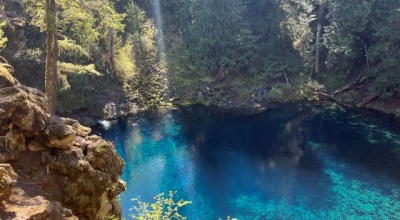Central Oregon groups get creative to manage recreation growth in the region
Published 5:00 am Tuesday, May 28, 2024

- Bend Growth Survey QR Code 2024
Easy access to outdoor recreation has long been a key driver for Central Oregon’s rapid growth.
People want to live close to wilderness, hiking trails, mountain bike singletrack, fly-fishing streams, ski hills and trails and all the outdoor activities this region offers.
As outdoor enthusiasts move to the High Desert, the population continues to increase and favorite recreation spots are not immune to the impact. Government agencies, community groups and nonprofits have worked feverishly during the last two decades to provide premium outdoor experiences to the masses while also managing crowds — locals and tourists — in cherished spaces.
In many cases, these groups have grown right along with Central Oregon.
Central Oregon Trail Alliance
When Phil Meglasson was working for the U.S. Geological Survey creating topographical maps in the early 1980s, he discovered an efficient way to go about his business — riding his bike through the woods.
Meglasson, the “Phil” of the famed Phil’s Trail Network west of Bend, and several other Central Oregon mountain biking pioneers began riding deer trails and logging roads in the area and forming them into biking trails. Their early labors eventually turned Central Oregon into a mountain biking mecca, and spawned the formation of the nonprofit Central Oregon Trail Alliance (COTA).
Today, COTA has six chapters, a paid staff of five, and maintains 600 miles of trails throughout Central Oregon. COTA was formed in 1992 and its mission is largely the same as it was more than 30 years ago: develop, protect and enhance the Central Oregon mountain biking experience.
In 2020, Emmy Andrews became COTA’s first executive director.
“Our budget has more than tripled even since I’ve been involved, and really needs to double again to really take care of the trails in a way that both residents and visitors expect,” Andrews said.
COTA has helped deal with crowds on the trails by designating some trails as directional (one-way) and educating riders about trail etiquette. Directional trails allow for minimal encounters because bikers will not come across other bikers riding in the opposite direction. They are also beneficial on downhill trails on which riders may not have time to stop for uphill riders.
“It helps you feel like you’re the only person on the trail because you’re rarely getting passed in that way,” Andrews said. “Passing in our dry environment tends to widen the trails. So it helps trails stay singletrack because there’s not so many people getting off the trail.”
COTA also tries to ensure that mountain bikers know the proper trail etiquette.
“Bikers yield to hikers and horses,” Andrew said. “Downhill bikers yield to uphill bikers. Let’s all just be nice, smile and say hi, and treat others as you would like to be treated. Those are three things we hope people will remember.”
More coverage: Trail work to make Bend a destination for adaptive cyclists
COTA can always use more volunteers to help with building and maintaining trails, but Andrews is not worried about any shortage of volunteers. She said that COTA’s volunteer hours in 2023 were the equivalent of having 10 additional staff members.
“It’s absolutely massive,” she said. “And trail work is not easy. It takes hundreds and hundreds of hours and volunteers who are sticking around and taking the time to gain those skills, and can help with a variety of tasks.”
Andrews said that COTA survives on the donations of riders and encourages local mountain bikers to become COTA members at a level that makes financial sense for them.
“Access to the outdoors is free for those that need it to be free, and the way that happens is the folks that can afford to pay it forward do, and that’s how we survive,” Andrews said. “There’s so many amazing ideas that are just sort of waiting in the parking lot because we just don’t have the financial support to do them. We’re growing, and we’ll get there.”
COTA works in conjunction with the Deschutes National Forest to ensure that trails do not affect biologically sensitive areas and are built in places that make the most sense environmentally.
Deschutes National Forest
The Deschutes National Forest had less than two million visits per year in 2013, compared with a projected five million in 2024, according to Kaitlyn Webb, public affairs and partnerships staff officer for the Deschutes National Forest.
Webb pointed to impacts on infrastructure (servicing, maintenance, repair), increased pressure on wildlife and changes in how people want to use the forest as some of the most significant challenges. The popularity of “van life” and the effect of social media on promoting nature are two recent trends that impact the forest.
“RVs are bigger and many people seek sites with power, water and sewer facilities, which are limited at Forest Service campsites,” Webb said. “More people have camper vans or other equipment that facilitates dispersed camping. Emerging technologies, new activities and equipment, and social media drive visitation patterns and all impact how people seek to use public lands. Expectations for immediate information, opportunities for access and level of services have increased.”
The Three Sisters Wilderness west of Bend is one of the most used wilderness areas in the state, giving hikers access to incredible alpine scenery and high lakes, and the opportunities to summit Cascade volcanoes.
One of the most dramatic changes to the way that the wilderness area is managed came in 2021, with the implementation of the Central Cascades Wilderness permit system. Hikers must purchase a permit in advance in order to hike certain trails within the wilderness area on both the Deschutes and Willamette National Forests.
Since the system was introduced, the Deschutes National Forest reports reduced crowding on trails and better distribution of trail users. But it can still be difficult for hikers to obtain permits on the days they want.
More coverage: Central Cascade Wilderness permits and how they work
Webb said the Forest Service relies heavily on its network of more than 2,000 volunteers, including the Deschutes Trails Coalition and COTA.
“We also work with other agency partners to ensure that we highlight the wildlife and other resources that rely on functional forest systems,” Webb noted. “Communicating to users the impacts that recreation has on the environment is critical. People don’t always see how recreation choices, from an individual action to infrastructure development, can impact not just habitat but survivability of a species. As use continues to grow, we’ll continue to be challenged to retain and re-establish quality habitat for a variety of species.”
Meissner Nordic Club
The Meissner Nordic Club is another Central Oregon nonprofit that works hand in hand with the Forest Service to manage recreation. What started as the small Tumalo Langlauf Club in the mid-1990s, designed to teach cross-country skiing, is now focused on grooming trails for cross-country skiers at Virginia Meissner Sno-park, just 15 miles southwest of Bend.
While the Mt. Bachelor Nordic Center offers a vast trail network, Meissner provides a more accessible location closer to town. As the region has grown, Meissner Nordic has been key in expanding snow sports options.
Meissner Nordic Club president Steve Roti said the sno-park is a complement to Mt. Bachelor, not competition. Skiing is free at Meissner, as the club pays for the sno-cat grooming through donations. Roti estimated that about 80% of Meissner’s visitors are Central Oregon residents.
“A big group that we are very proud to serve are all the local high school nordic teams,” Roti said. “It’s an accessible place that’s closer to town. It’s easier for them to ski at Meissner than at Bachelor.
More coverage: Meissner is Central Oregonians’ go-to for snowshoeing and cross-country skiing
“As things grow we have adapted.”
In 2016, grooming took place four days a week at Meissner, according to Roti. The past couple of seasons, that has increased to seven days per week.
“So we have a much better product,” Roti said. “When you don’t groom every day during freeze-thaw, the snow gets rough. That’s been a big change.”
That has made for happy skiers — and more donations.
“The amount of support we get from the local community is phenomenal,” Roti said. “There’s so much goodwill that comes from the grooming at Meissner. We’re funded well enough to keep grooming seven days a week well into the future.”
While the parking lot and the trailhead can become busy on winter weekends at Meissner, skiers can typically escape the crowds just a mile or so down the trail. And Meissner Nordic currently has a proposal before the Forest Service to create a new trail for beginner skiers. The working name is the High School Short Loop, and Roti likens it to a smaller version of the oval at the Mt. Bachelor Nordic Center.
“We tried it out in March and April and it worked well,” Roti said. “Coaches can take their teams there. That would cut down on the crowding.”
As Central Oregon continues to grow and its reputation as an outdoor recreation hotspot becomes increasingly visible, local groups that are passionate about their playgrounds will no doubt continue to find creative ways to manage them.
Central Oregon growth: a yearlong series
The Bulletin is continuing its yearlong series about the impacts and solutions related to growth in Central Oregon.
We’re comparing how civic groups, government officials and local leaders addressed growth 25 years ago to today, with a focus on four areas — environment, infrastructure, economics and housing. Bulletin reporters will examine the success of previous solutions, current approaches to growth issues and what other cities are doing to mitigate problems related to rapid increases in population, housing shortages, economic challenges and environmental impacts.
Help shape
our coverage
We’re looking to connect with community members who can help shape our coverage. Please take a few minutes to give us your input by going to www.surveymonkey.com/r/BendGrowthSurvey.






